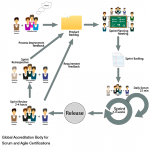The success of today’s organizations depends on how well they can adapt to the hurricane of changes sweeping across their industry. How can they do this? Many organizations are looking to Agile as the answer.
In step with its growing popularity, Agile has been embraced more warmly by large organizations. However, they face significant obstacles, such as the fact that large organizations do not undertake major changes unless absolutely necessary. Another challenge is related to the fact that Agile is different from traditional project management philosophies from the roots to the leaves. Large organizations are quite orthodox when it comes to their organizational structures and management.
Successful implementation of Agile in a bureaucratic environment is extremely difficult, because one of the core foundations of Agile is continuous process improvement, while moribund bureaucracy stakes its survival on the illusion of process stability. However, big organizations are beginning to be attracted by the importance and success rate of Agile. Software conglomerates such as Microsoft, IBM and SAP have successfully implemented Agile for select product development projects and continue to do so. Crack Sell
For Agile to be successful, an organization has to decide that it is ready to implement Agile’s core principles. It has to break free of its established ways to embrace the Agile culture. It is essential for a company to understand the conditions in which the implementation of Agile will lead to success:
- Condition 1: Short and frequent iterations during which problems can be identified faster than in extensive project cycles which tend to hide issues until the very end of the project
- Condition 2: The project includes customer involvement during the project development. If the company is strict about a bureaucratic and form ridden route to get to the customer, Agile will hobbled by the same red tape.
- Condition 3: Empowering the team to take decisions about development is a necessary component of achieving success in Agile methodology. Agile will fall flat, if the company believes in a rigid hierarchy of decision making.
- Condition 4: Agile stresses the importance of a working product instead of documenting the codes, which can be done later. If the company has to rely on extensive documentation for audits, then Agile may provide less than the desired process improvements.
These conditions are shared here to help companies from blindly, adopting Agile incompletely and then claiming that Agile does not work. Any large organization must take into account its immediate business needs and available resources, and understand clearly what exactly it desires to achieve. Then the executives of the organization should decide whether to adopt the Agile philosophy and frameworks totally or take a pragmatic approach. Whatever decision they take, unwavering and holistic executive support is one of the primary requirements for Agile to work in a large organization.










